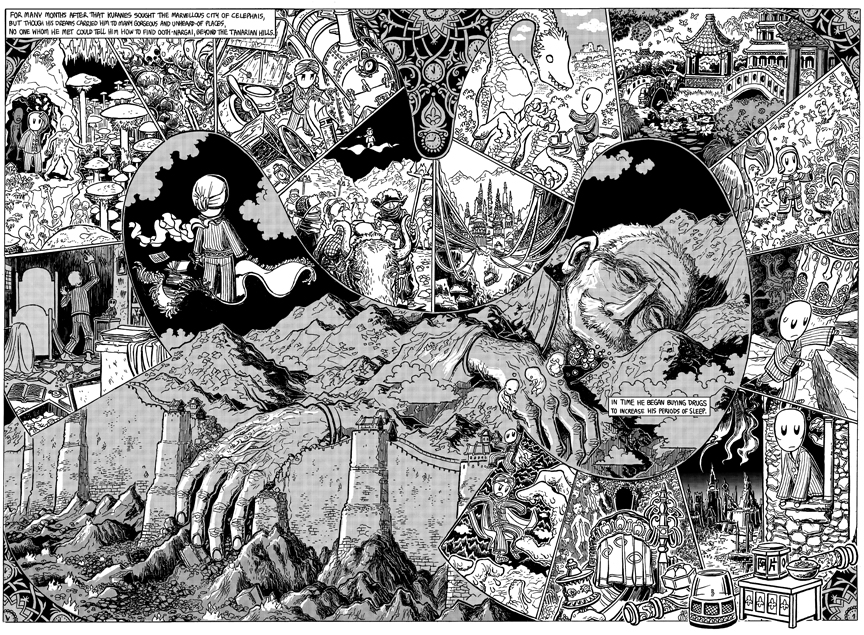Celephais, Pages 8-9
Click here for a bigger version of the image. Just clicking on the image won’t work, for weird WordPress reasons.
At last, here’s the new page — technically two pages, if it were in print — of Celephais. Like all my pages, this was drawn on 18″x24″ bristol board. Unfortunately, while trying to upload this page I discovered that ComicPress doesn’t support extra-wide pages, so I couldn’t make the page wider. Instead, the close-up, detailed version of the image is at a separate link (see above).
There’s only three pages left! The next page will go up on August 26! We’re also working on some new stuff and trying to produce a print edition of these comics. Please stick around and we’ll have more info in about two weeks!http://mockman.com/wp-admin/post.php?post=297&action=edit
NEXT UPDATE (honestly): Friday, August 26

I love that he has arabic coffee with a dragon. What a breathtaking level of detail! So delightful!
I am seriously awe-struck by this update. It’s absolutely beautiful. And it’s such a wonderful use of the comics medium – here’s something that you could not do in any other format.
To be honest, all of these adventures look so much more interesting than the city of Celephais. I think if I were Kuranes, I wouldn’t worry about it too much.
I’m a little worried by how the cut between the pages will work in book format, to be honest. In a graphic-novel-sized book, you can’t completely open up two pages, so the middle part will be lost, or you’ll need to put some kind of space in between.
you should offer a poster print of this page as one of your kickstarter gifts!
Actually, upon further reflection, if a graphic novel has SEWN rather than GLUED binding, it won’t be a problem… at least as long as the spine is flexible enough to open the pages all the way, which isn’t always the case. The binding in the “King Aroo” collection is a good example.
Apparently, it’s called “smythe-sewing”. A helpful guide to the difference here:
http://thefoolishgalatian.wordpress.com/2008/06/26/how-to-determine-if-you-have-a-glued-or-sewn-binding/
Oddly enough, I’ve never seen a Western graphic novel with sewn binding, though I’ve seen it done in Russia. Strange, because it works so well.
@Esn – Thanks for the ideas about the binding. I’m concerned too… although it also wouldn’t be too hard for me to add some disposable interior art (like the corner patterns) in the central fold area, since only the landscape image actually continues from the left side to the right side. I’ll ask the printer about sewn binding!
Well, I’d love for the final book to be smyth-sewn-bound, personally… although something like that does tend to cost more, I think that in your case the ability to see the comics are they were meant to be seen would be a huge practical bonus. This isn’t the only place in your Lovecraft stories where you have a 2-page spread, is it?
There are different types of sewn binding, as well. The proper smyth-sewn variety of the type that I think would work well looks like this:
http://www.couturebook.com/blog/content/binary/side%20of%20book.jpg
The spine is very flexible, and it’s possible to open pages almost 180 degrees. That’s because every 16 pages are actually 4 double-pages, sewn to the cloth spine at the back in the middle. Similar to what comic books do with staples, except using thread instead of staples.
I also found an interesting website for comic hobbyists who bind their issues into books after buying them, which has some photos of examples:
http://www.houchenbindery.com/comicbooks.htm
In their example of smyth-sewing the spine doesn’t seem to bend very much – at a guess, probably because the cloth spine is glued too closely to the hardback spine; there has to be some extra cloth there to give it room to bend properly.
Regarding Kickstarter: I can also see advantages to the typical paperback – namely, that they’re inexpensive and not heavy. Which equals lower buying and shipping costs, as well as easier to hold when reading.
Although I think it’s also possible to make hardcovers not too heavy – they just MAKE them heavy here in the West by making the hard covers out of a thick, heavy material and the pages as well. Russian hardcover books tend to be twice as light as Western ones. But I have no idea where to find information on why that is – a Google search reveals nothing.
ESN raises a good point. Kuranes’ fixation with Celephais seems to blind him to all the other wonders in the Dreamlands (not to mention anything of value in real life). I suppose one’s view of whether the story ends in triumph or tragedy largely depends on how much you buy into the reality of the Dreamlands. It’s interesting that HPL leaves the interpretation up to the reader (although he seems to approve of Kuranes’ choice). I don’t know; the story’s final image seems mighty disquieting to me. Is Lovecraft saying that Celephais is worth pursuing even if it is only a dream or a dying man’s illusion?
The central image of the sleeper’s bedclothes transformed into mountains and fortress wall is amazing. This would make an awesome poster!
Sorry to be a bother, but the link to the larger version appears to be broken?
@RGD — Thanks for finding the broken link! I fixed it, it should work now!
Thank you very much!